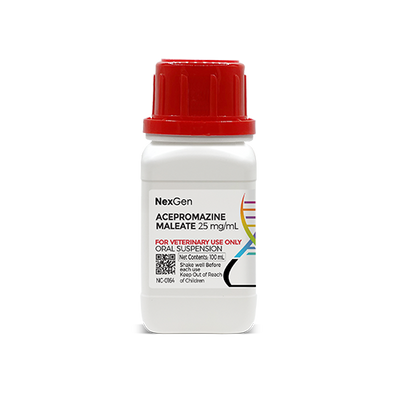
Ketoconazole 200 mg/mL, Oral Suspension, 100mL
Login for pricing
- Brand
- Mixlab
- SKU:
- NC-0257
- Product Type:
- Suspension
- Size:
- 100ml
- Administration:
- Oral
- Therapeutic Class:
- Antifungal
While some fungal diseases are regarded as nuisance infections (such as ringworm in cats), fungal infections can cause significant morbidity and mortality in both dogs and cats. Young adult, large breed dogs are more prone to fungal infections, while cats generally do not have predictable predispositions. The available literature holds that intact cell-mediated immunity is essential to initial resistance to infection and response to treatment. Several body systems can be affected by fungal infections in dogs and cats. Diagnosis can be confirmed on the basis of clinical signs and, in most cases, identification of the causative organism.1
Blastomycosis, histoplasmosis, coccidiomycosis, and cryptococcosis represent the four most common systemic fungal diseases that affect dogs and cats, and serological analysis can be helpful in the identification of coccidiomycosis and cryptococcosis infections. Treatment is often complicated by limited availability of fungicidal antimicrobials and the necessity of long-term treatment with drugs that are often expensive.1
Localized Fungal Infections
Fungal infections which affect the skin of a dog or cat can be difficult for owners to detect, since the scratching that typically arises with these infections is often thought to be the result of dry skin or flea bites.2 There are two common forms of skin fungal infections that are commonly seen in dogs and cats:
Ringworm
Dermatophytes, commonly known as ringworm, is caused by various pathogenic fungi. Ringworm in dogs and cats is extremely contagious (including its ability to spread to humans) and is acquired through direct contact with the fungus. Ringworm affects the skin, fur, or nails. Symptoms include hair loss, itching, flaky or crusty skin, and misshapen or brittle nails.
Fungal Dermatitis
This is also called yeast dermatitis or Malessezia dermatitis and is caused by the Malessezia pachydermatis fungus. This inflammatory skin condition can occur when the yeast that normally lives in the ears, mucocutaneous areas and skin of a dog or cat reproduces uncontrollably and overpopulates these areas.1 Symptoms include itchiness, flaky or crusty skin but can also include ear infections. Treatment of fungal dermatitis is often a long-term proposition. If an animal has an underlying issue (such as a compromised immune system or allergy), controlling these conditions will often impact the outcome of treatment.
Systemic Fungal Infections
Systematic fungal infections invade the inner body systems of a dog or cat.1 These infections can be seen in the lungs, nasal passages, bones or eyes. Some of the most common systematic fungal infections seen in dogs and cats include:
Aspergillosis
This is a fungal infection in dogs that is caused by a number of different Aspergillus species that are ubiquitous in soil. Nasal cavity, sinus, and lung forms have been described in domestic dogs and cats.1,2 Cats that are immunosuppressed or stressed by disease (such as viral infection) may be more likely to become infected. Signs are nonspecific and include inflammation of the sinuses, facial swelling, and pneumonia. The fungus can also invade the central nervous system and cause neurologic signs (such as seizures). Establishing an accurate diagnosis can be difficult and may require x-rays, computed tomography, and laboratory testing.2
Disseminated (systemic) aspergillosis is a generalized, and deadly fungal infection most commonly seen in large breed dogs. In cases of disseminated aspergillosis, the fungus enters the respiratory tract of the dog then makes its way into the bloodstream and throughout the dog's body. This fungal infection can affect a dog's organs, muscles or bones. The prognosis for dogs with disseminated aspergillosis is poor although in rare cases treatment has been successful.1
Cryptococcosis
Cryptococcus is found in soil around the globe, but is most abundant in areas where birds gather in large numbers.1,2 A dog or cat will inhale the fungus, which leads to a lung infection. This fungal disease initially affects the respiratory tract, but progress into the central nervous system, eyes, and skin. Symptoms of cryptococcosis in range from lethargy, coughing, nasal discharge, eye problems, and skin lesions, to seizures and other neurologic abnormalities.
Coccidioidomycosis
Also called Valley Fever, coccidioidomycosis is a dustborne, noncontagious infection caused by the fungus Coccidioides immitis. Infections are generally limited to dry, desert-like regions of the southwestern United States and similar geographic areas of Mexico and Central and South America. The route of infection is via inhalation of fungal spores. Epidemics nave been known to occur when rainy periods are followed by drought.2
Blastomycosis
Caused by the fungus Blastomyces dermatitidis, blastomycosis typically takes the form of a lung infection in hunting dogs in the mid-Atlantic and northeastern states in the US. Blastomyces thrives near beaver dams and other areas where moist, acidic soil rich in decaying vegetation exists. Symptoms of blastomycosis in the lungs include coughing, fever, lethargy, loss of appetite and weight loss. Advanced cases result in lameness, blood in the urine, eye problems, skin lesions and fever.1,2
Histoplasmosis
Histoplasmosis is a noncontagious infection caused by the fungus Histoplasma capsulatum, which is found worldwide. It is believed to be distributed via bird and bat populations in the midwestern and southern US, particularly in river valleys and plains. Infection occurs when spores in the air are inhaled. The lungs and the lymph nodes in the chest are the sites of primary infection.2
Where to buy Ketoconazole
Ketoconazole is available in the U.S. through several pharmaceutical manufacturers and through veterinary custom compounding companies. KETOCONAZOLE 200 MG/ML oral suspension by NexGen Pharmaceuticals provides a superior, easily-assimilated alternative to tablet forms of Ketoconazole.
Ketoconazole carries numerous potential drug interactions. Please consult your veterinarian prior to beginning any treatment regimen.
FOR RX ONLY: A valid prescription from a licensed veterinarian is required for dispensing this medication.
1Kerl, M. Update on canine and feline fungal diseases. Vet Clin North Am Small Anim Pract. 2003 Jul;33(4):721-47.
2Merck Veterinary Manual.




















